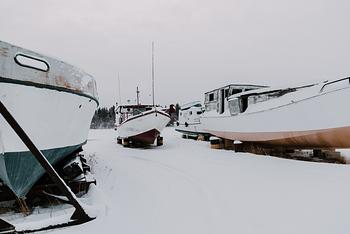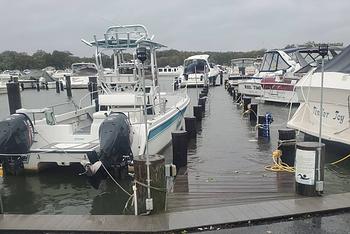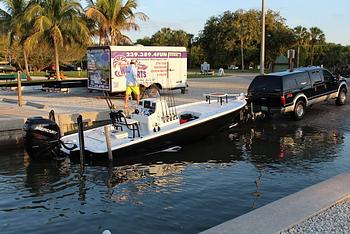The winter stretches out for months in many parts of the world, and that’s a whole lot of time to have your boat all tucked up and not being used. Trust us, boating withdrawal is real. If you live in a place where ice and snow don’t put stop to boating activities, then there’s no reason you shouldn’t be out in the fresh sea air doing what you love best. There are several considerations to take into account when winter boating and one of them is staying warm. There is nothing worse than spending a day cold, wet and miserable.
The sheer variety and options of sailing gear on the market are staggering and can be overwhelming even for seasoned sailors. Here we take a look at what you really need to keep you warm, dry and comfortable onboard in even the most adverse of weather conditions.
The Bottom Line
There are a few general rules to follow when it comes to staying warm at sea. Firstly, it’s all about layers, You can have the best foul weather gear money can buy, but if you don’t have the right undergarments you will be cold before you’ve left the marina. Layers will trap air in between them, keeping you warmer. Secondly, stay dry! While this seems like an obvious one, water will do its best to find any opening and seep in, so good seals, flaps and boots are a must. Most sailing gear these days is breathable which prevents condensation and dampness building up inside the clothing. Lastly, you need to be comfortable. Winter sailing gear can get bulky and you need to be able to move around the boat with ease, especially if you’re sailing. Once again layers are the way forward, allowing you the option to remove them when you get warm.
Thermals and Undergarments
Starting at the very bottom layer, thermals and undergarments are essential for any kind of winter boating. Worn against the skin they trap your first layer of warm air and keep you toasty at the core. Breathable fabrics are a good idea to stop condensation and sweating by absorbing the moisture quickly.
A microfleece thermal base layer is, as the name implies, extremely thin and breathable, and you can find them with high tog ratings of 0.61 from manufacturers such as Heat Holders, as well as sailing brand such as Helly Hansen. On your bottom half, base layer trousers are the sailing equivalent to Long Johns (which will work just fine too). Manufacturers such as Musto are now producing specially engineered, close-fitting trousers that provide warmth, ventilation, and protection by using a mixture of polypropelene, polyester, and elastane combined with a seamless body mapping.
The next layer up involves a slim fleece jacket, which again provides warmth without being bulky. In dry conditions, you might find that this is enough, but otherwise, it makes a perfect mid-layer. These don’t have to be from specialist sailing brands, and there are many top-quality outdoors brands producing them these days.
Hats and Gloves
Keeping your head warm is critical, and a good, fleece-lined, well-fitting thermal sailing hat is one of the best bits of sailing gear you can buy. There are hundreds of fleece-lined options on the market, so you don’t need to buy from a specialist sailing shop. However, companies such as Gill, Musto, and SealSkinz have gone a step further and created triple-layer thermal hats that come with ear flaps, a chin strap, and small visor to keep the lower winter sun out of your eyes.
Cold fingers are unfortunately almost unavoidable in the winter. Even with the thinnest neoprene gloves, you’ll find yourself taking them off to complete most tasks on board. Those designed for racing sailors have been pitted against some of the fiercest winter conditions and are close-fitting allowing for maximum control and responsiveness when handling sheets and lines, as well as offering maximum grip and warmth. If you’re going to be sailing, then you might want to consider short-fingered gloves that allow for more maneuverability while still keeping your hand warm. Good brands include Ora, Gill, Musto and Henri Lloyd.
Sailing Smocks and Waterproof Jackets
A set of winter waterproofs is likely to be your top layer and again being water-resistant and breathable are vital, as is being windproof. Whether you opt for a sailing smock or jacket – we’ll get to the differences in a minute – you’ll find a huge variety of options on the market with a bewildering array of terminology and features to choose from. Extensive research has gone into these highly technical garments, with manufacturer Gill using the world’s top racing sailors to test their products in the toughest of conditions.
Three-layer breathable fabrics are most common, providing protection from wind, rain, and spray (but not total immersion) whether you buy a smock or jacket. The difference between the two essentially comes down to a zip, or lack thereof in the sailing smock. Pulled over the head, the smock creates more of a seal than a jacket by using an elasticated hem and sometimes neck to keep water and wind out. The lack of a zip means there is no risk of a seal failure, although with modern technology and zip flaps this is rarely an issue for jackets. What you do get from a smock are more movability and less bulkiness. Top smock manufacturers include Henri Lloyd, Ronstan and Zhik Isotak.
Having said all that, sailing jackets allow you to control your body temperature, removing and putting them on easily and are therefore the more popular choice for amateur sailors and boaters. You also get a fully-adjustable, fleece-lined hood. You can choose from hip-length jackets or three-quarter length, bringing the protection down your body and minimizing water getting in. They are lightweight, have fully sealed seams, and sometimes features such as engineered reflective detailing for low light conditions. Whichever you opt for, make sure when trying them on that you account for the under layers otherwise it’ll be tight and hinder movement.
Footwear
Warm, dry and non-slip are the three key requirements for winter sailing footwear. For the occasional sailor, an affordable lightweight, fleece-lined rubber boot by manufacturers such as Main Deck, Crewsaver and Gill may be enough if you wear plenty of thick socks, but if you plan on doing longer or more days out you might want to invest in a boot made of waterproofed leather. Dubarry, Main Deck, Musto, and Orca Bay have some hard-wearing options, some of which come with built-in gaiters that stop water getting into a dry suit if you’re wearing one. They will also come with thermal insulation, reinforced toes, as well as non-marking, durable PU/rubber outsoles for extra grip.
Dry Suits
For winter day sailing, the waterproofs we’ve looked at above are going to be more than sufficient to keep you protected from the elements. However, if you’re planning on going offshore, sailing in very bad weather conditions, or sailing dinghies, then you might want to consider investing in a dry suit. These don’t come cheaply, so if your winter sailing days are limited to a crisp wind then you won’t need them.
Essentially a dry suit is a loose-fitting outfit that is waterproof. Constructed from layers of insulating fabric they protect your whole body except your head, hands, and feet. Differently to neoprene wetsuits which are designed to be worn in warmer conditions and don’t keep you dry, wetsuits create a full barrier and tend to include an outer membrane made of rubber or nylon, an inner shell made from a thermal fabric or neoprene, and neoprene seals around the neck and wrists. Top brands include Gul, Typhoon, Crewsaver, and Musto.
Read On, if interested in these topics:
Top three Winter Cruising Destinations, which is still the Best
Five Sailing Movies to Watch in the Winter
Simple measures to keep your boat safe in Winter




